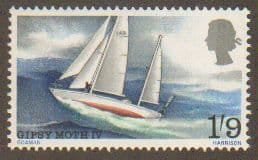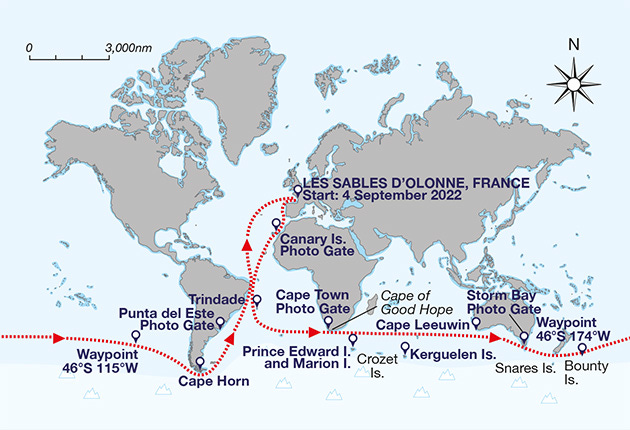How sailing across oceans non-stop started
Today people race around the globe to win a prestigious cup
Francis Chichester was flying a plane to New Zealand. This does not sound complex in itself, but this was the 1930s. Francis was flying solo. He used one hand to make map readings on paper based on the sun’s position, while steering the plane with the other. From the map readings, he would need to make long division calculations in his head, draw graph lines and plot paths to navigate his way. This was par for the course for pilots in the 1930s, before electronics, navigation instruments, radar, air traffic control or Siri could help provide directions.
We can all say that Francis Chichester fared extraordinarily well at flying solo, since he never once crashed his plane into the sea. Francis, an Englishman, was fond of adventure. He tried his hand at a great many things. In the 1930s, he learnt to fly planes and made solo trips across the Pacific and Atlantic. As he grew older and could no longer fly planes, he took to sailing. In 1966, he left the port of Plymouth in England and set sail solo, to complete a circumnavigation of the globe. Many people had circumnavigated the globe (i.e. sailed across the globe one full round). But he wanted to be the fastest to do this. So he chose a slightly smaller boat than what most other sailors had used before.
He did it! He was the fastest to have accomplished this, as of 1967. He reached Plymouth nine months later, in 1967. He had made just one stopover at Sydney. Francis expected his wife to welcome him with much joy. Much to his surprise, even the Queen of England joined in the revelry and she knighted Francis. The British Postal department was not to be left behind. They released a stamp in his honour (pic below).

When adventure meets competition
What do you think other sailors wanted to do, after seeing Francis Chichester’s accomplishment? Of course, they wanted to beat his track record - circumnavigate the globe, but this time, WITHOUT a stopover!
For the first time, in 1968, the Sunday Times newspaper announced that it was sponsoring a race for sailors to circumnavigate the globe solo. This race was to be called the Golden Globe Race (GGR).
In the first edition of the GGR, nine men set sail from England. The route they were going to take was treacherous, to say the least. They would set sail from Europe, down the Atlantic. They would reach the southernmost tip of Africa (near Capetown), turn towards the Indian Ocean and sail onwards till they reached New Zealand. From thereon, they would sail across the Pacific Ocean and reach the southernmost tip of South America. From here, they would go back home, sailing across the Atlantic and go up north. The map below is the route sailors took in the most recent edition of the race in (2022-23)
The fate of the first nine sailors
Nine sailors set sail in 1968. All of them worked hard in securing a good boat, that could stand being at sea for nearly nine months. The boat also had to weather the high waves, the strong winds and the unpredictable storms that were inevitable, anywhere on the high seas. Specifically, the boat had to survive the dangerous waters of the Southern Ocean. These were also called the Roaring Forties.
What’s Roaring Forties, you ask?
The Roaring Forties are the super-strong winds that occur in the Southern Hemisphere. These winds are common between the latitudes 40 and 50 degrees south. The air currents here are strong because of the high speed winds blowing from the equator towards the south pole (as the earth rotates). Also, in this region, there is hardly any landmass. The nearest landmass is the Antarctic, which is quite some distance away. Since there is nothing to break the flow of the bellowing winds, the seas here are way more turbulent than you see in the Northern Hemisphere. Pic below was taken recently aboard a ship facing the Roaring Forties.
Six of the sailors gave up or retired within just the first few months. They had barely crossed the Atlantic Ocean, before most of them retired. Either their boat had been damaged, or the boat had suffered repairs that could not be done by themselves while at sea (remember they had to sail solo, which means, they had to do all the repairs and maintenance, entirely by themselves, when at sea). Three of them continued to brave on. Of these, Robin Knox-Johnston and Nigel Tetley navigated the difficult storms in the Southern Ocean and made it all the way back to the Atlantic Ocean. Robin Knox-Johnston won the race. Sailing close behind him was Nigel Tetley. When he was very close to finishing the race, his boat sank (rescuers reached him in time and saved him).
The sailor who could not face the truth
One more sailor (Donald Crowhurst) did not complete the race. He barely crossed the Atlantic Ocean, since his boat was slower than he had anticipated. I won’t go into the full details of what happened to him. Here is the brief account below. But if you want a more detailed account, click here to read it.
Donald Crowhurst had borrowed huge sums of money to build this boat. The boat was going slow. He was also unsure if he would survive the Roaring Forties in his boat. He had two choices. He could admit defeat and retire right away. If he did so, he would face financial ruin as he had no money left to repay his lenders. Or, he could bluff about his position, stick around in the Atlantic Ocean, and join the boats returning on their way back. He could claim that he had circumnavigated the globe and had done so in excellent time.
He chose the second option.
These were days before we had satellites and GPS that could track the real position of boats. The organisers of the race depended on the sailors who would self-report their position via radio to their headquarters. However, upon return to Plymouth, their log books (books where they plotted their speed, distance, storm days etc.) would be analysed in detail. The log books of the first two winners were usually analysed. Beyond that, the organisers did not pour over the log books of the third person. Donald was hoping to be the third sailor in.
He patiently waited for Nigel Tetley to reach Plymouth. Unfortunately for him, Nigel’s boat sunk. Which meant, that if he returned home, his log books would be checked and the world would know that he had bluffed. Donald became depressed as he could not come to face the prospect of people booing at him. He never returned home after the race. It is suspected that he met his end in the sea.
Bluffing and cheating rarely workout in the long run!
Onto happier things
This race (GGR) is on even today. All sailors are allowed only those equipments that were available to Robin Knox-Johnston in 1968. Netflix and Youtube are out of bounds, as are smartphones. Armed with books to keep them company (in the absence of screens), a group of brave men and women assemble at a port in France each year in September and begin this adventure. In its most recent edition, Kirtsen Neuschaffer from South Africa won the race. It was the first time a woman had won the GGR. Coming a close second, was Abhilash Tomy from India. He is a retired naval officer. Abhilash is also the first Indian ever to complete this race.
In its most recent edition, 16 people began the race. 11 of them retired and the other 5 reached the destination safely. I was chatting with a 10-year old on a podcast and asked him about why he thought most sailors retired mid-way through the race. He came up with the following options. Which one do you agree is the most likely reason?
‘The Lighter Side’ is a weekly newsletter about real life stories from the real world. We cover a range of themes - science, countries, sports, people and much much more. Subscribe for FREE if you like the idea of reading such stories and staying updated about the real world around us.





